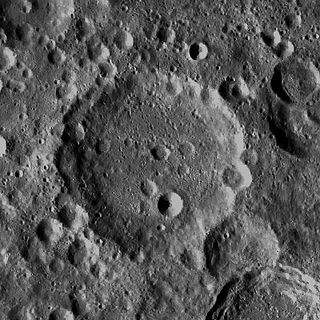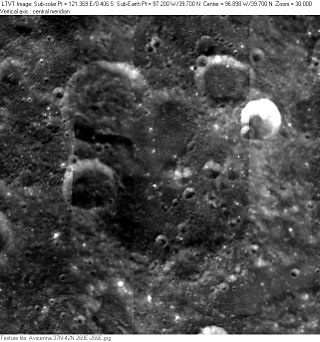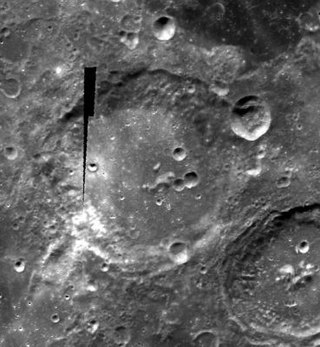
Anderson is a lunar impact crater that is located on the far side of the Moon. It is located to the northwest of the crater Sharonov, and the satellite crater Sharanov X is attached to the southeast rim of Anderson. To the northeast is the peculiar formation Buys-Ballot, and to the east-southeast lies the larger crater Spencer Jones.

Argelander is a lunar impact crater that is located in the south-central highlands of the Moon. It was named after the German astronomer Friedrich Argelander. It lies in the midpoint between the smaller crater Vogel in the north and the larger Airy to the south. To the northwest is the worn remnant of Parrot. Just to the west is a shallow cleft in the surface that follows a course to the north-northwest, intersecting the southeast rim of Parrot.

Cleomedes is a prominent lunar impact crater located in the northeast part of the visible Moon, to the north of Mare Crisium. It was named after Greek astronomer Cleomedes. It is surrounded by rough ground with multiple crater impacts. The irregular crater Tralles intrudes into the northwest rim. To the east is Delmotte. North of Cleomedes is a triple-crater formation with Burckhardt occupying the center.

Cavendish is a lunar impact crater that is located in the southwest part of the Moon, to the southwest of the larger crater Mersenius. It lies between the smaller craters Henry to the west-northwest and de Gasparis to the east-southeast.

Arrhenius is a lunar impact crater that is located just on the far side of the Moon, near the southwest limb. In this location the vicinity of the crater can be viewed during favorable librations, although it is viewed from on edge. To the south-southeast is the worn crater Blanchard, and De Roy lies further to the west.

Avicenna is a lunar impact crater that lies on the far side of the Moon, just beyond the western limb on the northern rim of the Lorentz basin. It is named after the Persian polymath Avicenna. It lies to the north-northwest of the larger crater Nernst, and to the southeast of Bragg.

Bose is a lunar impact crater that is located on the far side of the Moon, in the southern sphere hemisphere. It lies just to the northwest of the smaller crater Bhabha, and southeast of Alder.

Dawson is a lunar impact crater that lies on the southern hemisphere on the far side of the Moon. It lies across a crater triplet: the southeast rim is intruding into the crater Alekhin; the northwest rim also intrudes into the larger satellite crater Dawson V, and the northeast rim is attached to the comparably sized Dawson D. To the south of this formation is the large crater Zeeman. West of Dawson is the crater Crommelin, and to the north lies Fizeau.

Brianchon is a lunar impact crater that is located along the northwestern limb of the Moon. Due to its location, from the Earth the crater is seen from the edge and its visibility is somewhat affected by libration. Thus for a more detailed view, the crater must be viewed from orbit.

Borda is a lunar impact crater that lies between Santbech to the north-northwest and Reichenbach slightly further away to the south-southeast. It was named after French astronomer Jean-Charles de Borda. It has a low rim that is broken along the southeast by a smaller crater. The rim is intruded into by another small crater along the southwest side, and there is an irregular cleft along the northwest face. There is a central peak at the midpoint of the floor.

De La Rue is the remnant of a lunar impact crater, or possibly several merged craters, creating a formation sometimes called a walled plain. It lies in the northeastern part of the Moon on the near side, and so appears foreshortened due to its location. This formation lies to the north-northwest of the prominent crater Endymion, just beyond the eastern extreme of Mare Frigoris. The crater Strabo intrudes into the northern part of De La Rue's northern rim, and the smaller Thales is attached to the northwestern part of the wall.

Barbier is a lunar impact crater that is located on the southern hemisphere on the far side of the Moon. It forms a matched pair with Cyrano to the north-northwest, and it lies to the southeast of the huge walled plain Gagarin. Southwest of Barbier is the crater Sierpinski, and to the southeast is the Mare Ingenii.

Brouwer is a large lunar impact crater that is located in the southern hemisphere on the far side of the Moon. Intruding into the western rim of Brouwer is the younger and somewhat smaller crater Langmuir. Further to the east-southeast is the larger walled plain Blackett.

Dyson is a lunar impact crater, 63 kilometers in diameter, that lies on the far side of the Moon, past the northwest limb. It is located in the northern part of the surface, to the northwest of the crater Coulomb, and east of van't Hoff.

Curie is a large lunar impact crater, much of which lies on the far side of the Moon as seen from the Earth. The western rim projects into the near side of the Moon, as defined by the selenographic coordinate system. However the visibility of this formation depends on the effects of libration, so that it can be brought fully into view or completely hidden depending on the orientation of the Moon. When visible, however, it is seen nearly from the side, limiting the amount of detail that can be observed.

Cockcroft is a lunar impact crater that is situated on the far side of the Moon from the Earth, so that it has only been observed and photographed from orbit. It lies to the northeast of the larger crater Fitzgerald, and southeast of Evershed.

Congreve is a lunar impact crater that is located on the far side of the Moon relative to the Earth, and lies across the lunar equator. It lies to the west-northwest of the massive walled plain Korolev. To the southeast is the crater Icarus, and due north is Zhukovskiy.

Fourier is a lunar impact crater that is located in the southwestern part of the Moon's near side, just to the southeast of the crater Vieta. To the northeast is the Mare Humorum. The rim of this crater is roughly circular, but appears oval when viewed from the Earth due to foreshortening.

De Vries is a lunar impact crater on the far side of the Moon relative to the Earth. It lies about midway between the craters Racah to the north-northwest and Orlov to the south-southeast. An nameless walled plain lies between De Vries and Orlov, with the perimeter of this feature joining the two rims.

Fersman is a large lunar impact crater on the Moon's far side. It lies to the east of the crater Poynting, and west-northwest of Weyl. To the south is the huge walled plain Hertzsprung.




















